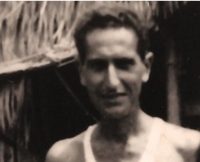An eventful day. Until ten o’clock nothing unusual. Market, breakfast, cleaning the house. At ten o’clock Betty [Lander] receives a telephone call from one of her friends interned in Santo Tomas, saying that it’s absolutely necessary for her and her friends to go there as soon as possible. Consternation all round. We make up parcels — cartons of milk for the children, tinned food, mosquito nets, bedding, etc. We find time to have a quick lunch, and at one o’clock, we find ourselves installed in five carretellas with the seven children. Mattresses are tied behind each of the carts, camp beds and cases protrude from each side, and our caravan sets off at a trot through the densely populated streets of our neighborhood, arousing the curiosity and provoking the smiles of passers-by. We go through much of the city, passing in front of numerous buildings burnt, not by bombs, but by the gang of looters who pillaged to their hearts’ content between the departure of the Americans and the arrival of the Japanese. The seven children are delighted by the ride.
At last we arrive at the gates of Santo Tomas. The Japanese sentry ends up by letting us in. An enormous garden where lots of people are lying on the ground — looks like a Sunday in the Bois de Boulogne. One man, bare-chested, is sunbathing. In a corner others are playing with a ball. Women in slacks and wearing lipstick are walking around as though in an elegant spa town. Many men unshaven. We stop in front of the Main Building and unload our baggage in the hall. A lot of people, men, women and children, pass to and fro. Some clean, well dressed and anxious not to “let things go”. Others slovenly, men unshaved, women with their hair in a mess.
I recognize a few friendly faces. “Oh, we’re fine” and “Could be much worse.” In fact some are sun-tanned and appear as carefree as before. But most are worried about food for the future. A Japanese soldier briefly searches the possessions we’ve brought. He scrupulously examines a child’s pistol in a toy-box.
While Anne waits for her exit pass — having a child less than one year old, she isn’t obliged to stay in Santo Tomas — several acquaintances approach me and, in a low voice, ask for news. I can only give them bad news. A magnificent American, white-haired and ruddy-cheeked, seems particularly anxious to know if, as rumor had it in Santo Tomas, the Australians have indeed landed in the Philippines. I’m obliged to disillusion him and he takes his leave, not without thanking me profusely, and not without telling me to be careful about spies inside the camp itself Other friends come to ask me to bring them forks, cups, shorts and tinned food.
Anne returns, holding her pass. She’s deeply upset, because she’s just visited the building where women and children are crammed together in the heat. Normally so courageous, it appears that even she broke down at the sight — and at the idea of having to stay in this filthy environment indefinitely.
Anne, the children and I get another caramata, reload the suitcases, mattresses and mosquito nets, and return to our peaceful Santa Ana — happy to be free. For how long, that’s the question. Anne will have to go back to be locked up in Santo Tomas when the little one is a year old — that is, at the end of February. But until then, perhaps she’ll be able to cope?
